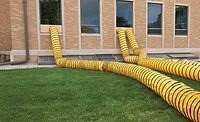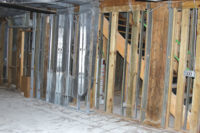Advancing the Science of Structural Drying
There remain numerous opportunities to expand innovation in the water damage mitigation industry

Ed Jones also contributed to this story
As an independent testing facility, CodeBlue is unbiased in its approach and application of the science of drying and looks for new drying technologies that meet criteria such as how to save the most building materials and contents, to dry as quickly as possible so the policyholder and their family get back to normal with the least amount of disruption and to dry in the most cost effective manner possible.
Such was the case recently when IICRC-approved instructor Ed Jones, CodeBlue VP of Education and Research and Development, met Ron Colling, Bridgepoint Systems National Restoration Manager, and Dr. Dan Bernazzani, Liberty Consulting, to investigate drying CodeBlue’s Disaster Recovery Learning Lab (DRLL) on the Clark State University campus in Springfield, OH using electric thermal energy system (E-TES) with and without refrigerant dehumidifiers.
Jones flooded the house on Sunday afternoon with approximately 1,500 gallons of water and allowed it to soak in overnight. Early the next morning, he re-flooded the house for four more hours just to make sure it was wet – really wet. Through studies at their flood houses, CodeBlue has advanced the science of structural drying rather than demolish walls and replace wet materials. Jones has successfully dried its Structural Drying Laboratory in Eau Claire, WI, located on the Chippewa Valley Technical College, and its Disaster Recovery Learning Lab in Springfield, OH over 65 times without replacing drywall, carpet, pad, hardwood, cabinets and contents.
The strategy with this experiment was to test directed heat thermal energy drying against traditional drying methods in a fully furnished house. We wanted to test three theories:
- Does directed heat thermal energy dry faster?
- If “yes” to (1), how much faster?
- And at what cost?
There were no guarantees that any of the theories would work, but good science dictates proving or disproving a hypothesis. We also wanted to find out how well the system worked using an open drying system and a closed drying system utilizing both directed thermal energy and dehumidification and that there would be no collateral damage.
For decades, our industry has tried to understand forces that influence the rate of drying. It is recognized that the “correct” balance of evaporative potential and dehumidification plays a critical role in facilitating proper drying. Claim dollars can also be saved through innovative drying technology. This perspective clearly has its roots in the way the disaster industry has evolved. Technical advances in low-grain refrigerant (LGR) dehumidification, air movers, negative mat systems and the like have made many drying situations technically feasible, but missing were testing facilities like those built outdoors to simulate water losses in the real world. They have formalized procedures that made scientific testing about how to dry wet houses feasible.
CodeBlue regularly performs industry technology testing at the structural drying laboratory. During their hands-on training, students get to see how different equipment (from variety of different equipment manufacturers) compares in a completely independent, unbiased atmosphere. They also get to see and test some of the latest procedures used by contractors, such as applied structural drying compared to desiccant and both directed and conventional heat drying.
Today, it is easy to take for granted things such as drying carpet. It’s porous and easy to dry when the water source isn’t contaminated - but what happens to the structural material? Virtually every aspect of drying relates to energy, especially evaporation and dehumidification.
According to the parameters established for this study, we would flood the house as it had been flooded many times before. Then, we’d use self-propelled specialty extraction tools to physically remove as much water as possible, just as it is during each class. Then, start the drying at the same time as has been done in the water damage restoration classes performed in the past while documenting the drying process. Once dry, we would compare the data to previous mitigation efforts, including costs of equipment. Costs are important to both contractors and clients, who, like every other business, have to manage risk.
Once the extraction process was complete, E-TES systems were set up in the kitchen and main living areas employing a “modified” open drying system and bedroom areas and the den were set up with E-TES units and a LGR dehumidifier. The basement and crawlspace were dried traditionally so we could evaluate data from these two drying chambers. E-TES’s Smart Dry System was utilized to control the temperatures of the ambient air in the affected areas and the temperatures of the wet surface materials.
Once the drying was complete (in record time - two days start to finish) cost data was analyzed using Xactimate. Bottom line, the drying was shorter by two full days and the cost to dry was approximately 1% less than the previously estimated drying costs. This included returning real hardwood flooring and engineered wood flooring back to pre-loss conditions in just two days! Of course this is just one experiment, but it illustrated that directed heat drying is a viable drying strategy. As Jones says in his classes, “We have much better tools in our drying toolbox available to us today then we have ever had before - specialty extraction tools, axial air movers, high-temperature low-grain refrigerant dehumidifiers that can operate efficiently at even higher temperatures, wood floor and wall cavity drying systems, desiccant dehumidifiers, directed heat and conventional heat drying. The key is to make sure the right tool is used properly and documented meticulously depending on each specific circumstance.”
There remain numerous opportunities to expand innovation in the water damage mitigation industry. Some assert that the industry hasn’t performed enough rigorous science-based studies. Until recently, not much research in the field of drying has been conducted under conditions similar to the real world. Science-based studies should help guide contractors and demonstrate to our insurance partners that advances in drying technology could help homeowners return to their flooded homes faster with much less replacement of costly structural materials and contents.
Looking for a reprint of this article?
From high-res PDFs to custom plaques, order your copy today!






